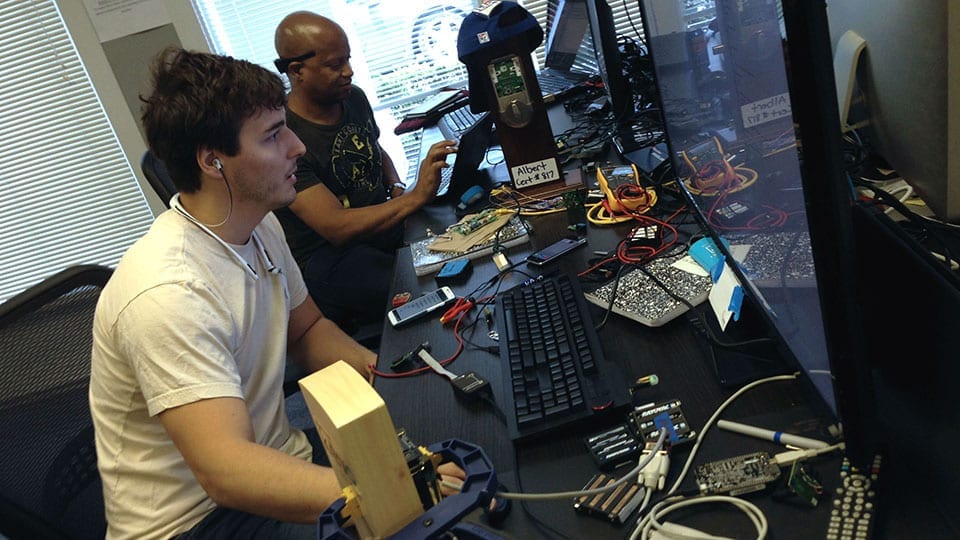[vc_row][vc_column][vc_column_text]
Pass Through Wormhole To Online Learning
Education is a social interaction, whether online or in person, says Sally Buberman, CEO and co-founder of Wormhole. That basic concept led to the creation of the first ‘Live Learning’ platform, a new concept in online education that disrupts the foundations of traditional e-learning and builds a new experience by leveraging mobility, gamification and people interaction to create the most engaging online training programs. It’s been a journey of epic proportions, from a small startup in Argentina to a customer base of more than 2000 companies, government organizations and educational institutions in 10 countries that continues to expand.
To scientists, a wormhole is a theoretical passage through space and time that could create shortcuts for long journeys across the universe. To Sally Buberman, Max Menasches and Ignacio (Nacho) Lopez, the word translates into providing enterprises and institutions a simple way to produce content, offer online training and still retain the best of live education.
The live piece, says Buberman, engages students more effectively by giving them the ability to talk openly with instructors as if they were together in the same room instead of waiting for occasional office hours. An online but live environment tends to be less intimidating than a person-to-person environment; it allows a student to take a live class while still allowing each to have a voice by share ideas and questions in real-time.
“I was giving online lectures over the Internet,” Buberman says. “I thought, ‘Why not create a reliable online university that offers real-time interaction between teachers and students?’”
Teachers, they theorized, needed a platform where they could create and retain their own content. And students from all walks of life needed a way to interact in real-time with their teams and instructors without having to travel to a specific location. This is also true in corporate and government training programs, where the company is focused now.
Pulling Max and Nacho into her plan, the Wormhole team ultimately decided to enter the Microsoft Imagine Cup competition (in 2007) as a way to obtain feedback and validation. The nature of Microsoft’s developer competition forced them to create milestones, build their first prototype and present the idea to others. Making it to the finals inspired the trio to quit their jobs and officially form their startup.
“At the time, we had almost no money to invest,” says Buberman. “We bootstrapped from scratch, worked on the side to generate revenue and reinvested all our earnings back into our little company. That was how we managed to hire the first employees who helped us develop the first version of our product – Wormhole Campus.”
From the beginning they chose to build their foundation on a mix of .NET and other open source software (OSS) packages. Linux, for instance, is Wormhole’s core operating system; C# and Java are the core languages used by the company. To scale-out easily, the startup uses a combination of Windows Server and Ubuntu Server. Wormhole also utilizes Joomla, a PHP CMS, for marketing websites and other internal developments, as well has having native mobile apps for Android and iOS.
Other OSS packages in use at Wormhole include Redis, MySQL, Nginx, Tomcat, Jenkins, a build automation tool, Apache Ant, a Java-based build tool and NAnt, a scripting tool for .NET that helps improve build functions.
Because Wormhole’s virtual classrooms offerings are 100 percent web-based, they don't require the installation of any software. They must, however, be able to work well under very low bandwidth and poor Internet connectivity in order to reach the most people. As the startup continued to grow at a very fast pace (their platform now has over 3 million users a month), it began to rethink its infrastructure architecture.
Before moving to Azure, says Lopez, Wormhole was managing every bit of its infrastructure by itself while hosting on private virtual servers and AWS. As it began researching Microsoft Azure, it discovered that Azure’s PaaS offering and managed services like Redis Cache and SQL Azure offered a simpler infrastructure and a new generation of computing that AWS didn’t have. The development team was quite surprised at Microsoft’s support for OSS technologies – it was expecting Azure to be 100 percent Microsoft-centered.
Joining the Microsoft BizSpark program, Lopez says, was a critical turning point for the startup because of the free licensing and tools it offered. It removed cost and technology barriers Wormhole was experiencing as it expanded.
“Being supported by Microsoft makes you feel comfortable,” Lopez explains. “When you are a startup with no funding, being able to have all the Microsoft software for free together with Azure Credits is an invaluable support.”
“We read a lot before making the move to Azure and also consulted with other startups that were using OSS on Azure to get their opinion,” says Lopez. “We learned that Azure OSS support was not something Microsoft created because it had to – it really wanted to help developers. And Azure overall has better integration (than AWS) with our development tools, so we realized it would help us streamline our development and deployment processes.”
As they continued to research Azure, they saw Microsoft starting to increase the speed of Azure feature releases, a lowering of costs to meet or beat AWS and a mix of PaaS and IaaS offerings with support for Linux, PHP and Java.
“We decided we need to try it out,” he says, “especially when we saw how easy it was to use the management portal and discovered it had automation capabilities, VMs with support for Windows and Linux and worldwide data centers that could help us as we grew.”
“We are making even more use of Linux and other OSS on Azure, because it's so simple to manage and maintain!” he says.
After entering – and winning – more competitions and receiving numerous awards after the Imagine Cup journey, Wormhole developed a board of advisors comprised of well-known industry leaders. It now feels ready to pitch investors in a bid to raise capital for further international expansion.
“As an entrepreneur,” reflects Buberman, “you face many challenges every day and you fail a lot as well. The only way to survive the entrepreneurial life is if you can transform every failure into knowledge and positive experience. Use all the materials you can get hold of – you never know which one will be the turning point for your company.”
Microsoft is helping these startups succeed through its BizSpark program.
About BizSpark: Microsoft BizSpark is a global program that helps startups succeed by giving free access to Microsoft Azure cloud services, software and support. BizSpark members receive up to $750 per month of free Microsoft Azure cloud services for 3 years: that’s $150 per month each for up to 5 developers. Azure works with Linux and open-source technologies such as Ruby, Python, Java and PHP. BizSpark is available to startups that are privately held, less than 5-years-old and earn less than $1M in annual revenue.
[/vc_column_text][/vc_column][/vc_row]
Continued Reading

July 13, 2016
Case Study: UniKey
[vc_row][vc_column][vc_column_text] Case Study: UniKey By Vanessa Ho as written on […]
LEARN MORECase Studies

July 13, 2016
Plug in to success—7 steps for a strategic technology lifecycle
Plug in to success—7 steps for a strategic technology lifecycle […]
LEARN MOREinthetechknow


